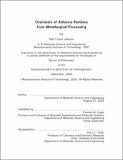Chemistry of airborne particles from metallurgical processing
Author(s)
Jenkins, Neil Travis, 1973-
DownloadFull printable version (22.56Mb)
Other Contributors
Massachusetts Institute of Technology. Dept. of Materials Science and Engineering.
Advisor
Thomas W. Eagar.
Terms of use
Metadata
Show full item recordAbstract
Airborne particles fall into one of three size ranges. The nucleation range consists of nanoparticles created from vapor atom collisions. The decisive parameter for particle size and composition is the supercooling of the vapor. The accumulation range, which comprises particles less than 2 micrometers, consists of particles formed from the collision of smaller primary particles from the nucleation range. The composition of agglomerates and coalesced particles is the same as the bulk vapor composition. Coarse particles, the composition of which is determined by a liquid precursor, are greater than 1 micrometer and solidify from droplets whose sizes are controlled by surface, viscous, and inertial forces. The relationship between size and composition of airborne particles could be seen in welding fume, a typical metallurgical aerosol. This analysis was performed with a cascade impactor and energy dispersive spectrometry with both scanning electron microscopy (SEM-EDS) and scanning transmission electron microscopy (STEM-EDS). Other methods for properly characterizing particles were discussed. In the analysis, less than 10% of the mass of fume particles for various types of gas metal arc welding (GMAW) were coarse, while one-third of flux cored arc welding (FCAW) fume particles were coarse. Coarse particles had a composition closer to that of the welding electrode than did fine particles. Primary particles were not homogeneous. Particles larger than the mean free path of the carrier gas had the same composition as that of the vapor, but for particles 20 to 60 nanometers, smaller particles were more enriched in volatile metals than larger particles were. This was explained by the cooling path along the bubble point line of a binary phase diagram. (cont.) Particles were not necessarily homogenous internally. Because nanoparticles homogenize quickly, they may form in a metastable state, but will not remain in that state. In this analysis, the presence of multiple stable immiscible phases explains this internal heterogeneity. The knowledge contained herein is important for industries that depend on the properties of nanoparticles, and for manufacturing, where industrial hygiene is important because of respirable particle by-products, such as high-energy-density metallurgical processing.
Description
Thesis (Ph.D.)--Massachusetts Institute of Technology, Dept. of Materials Science and Engineering, 2003. Vita. Includes bibliographical references.
Date issued
2003Department
Massachusetts Institute of Technology. Department of Materials Science and EngineeringPublisher
Massachusetts Institute of Technology
Keywords
Materials Science and Engineering.